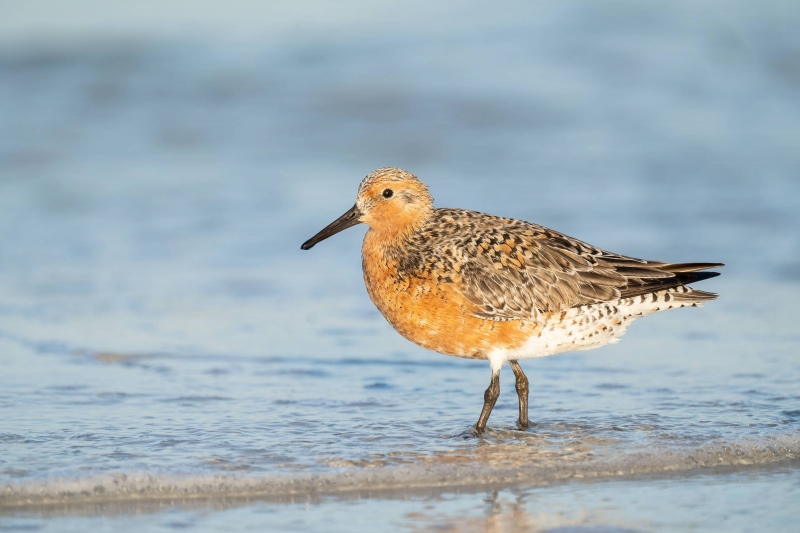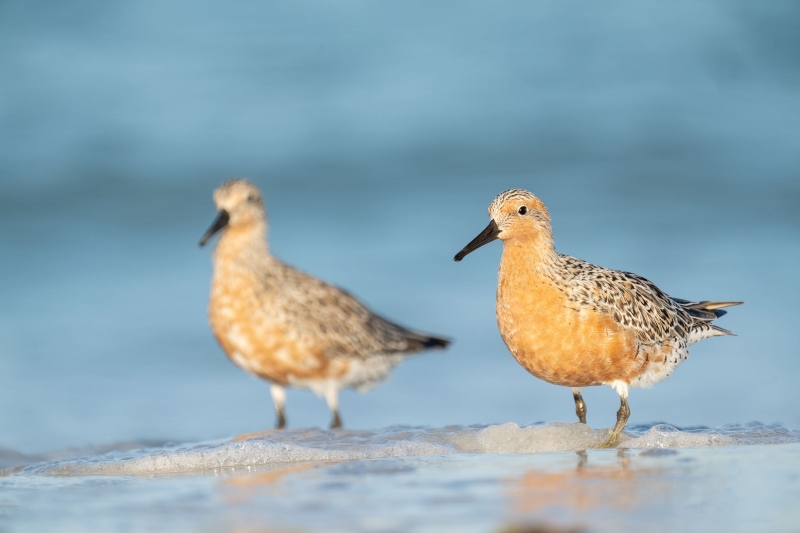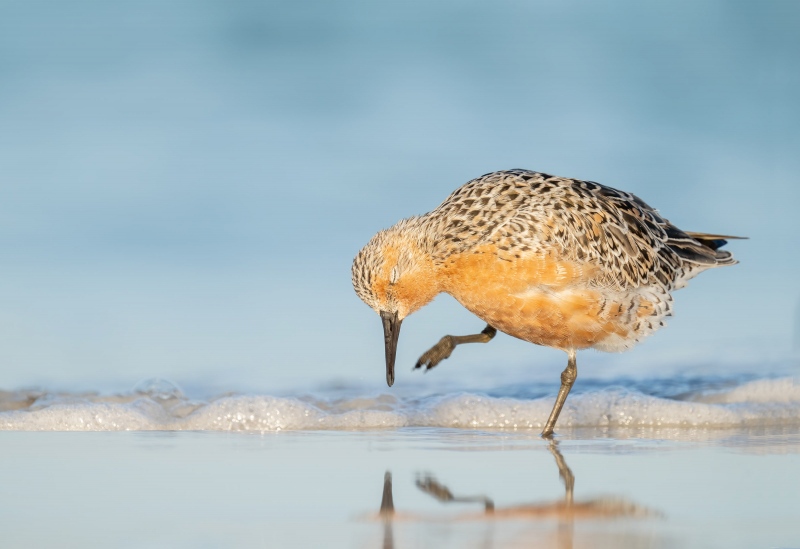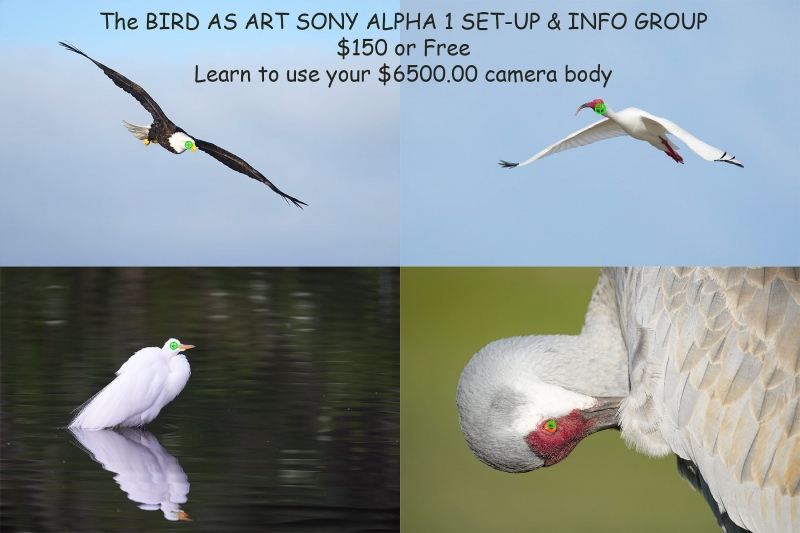Your Favorite Image?
Which of today’s three featured Red Knot images is your favorite? All are invited to leave a comment and let us know why they made their choice.
Just for the Record
If you are not using a Sony a1 for bird photography, you are making your life far more difficult than it needs to be. Period.
What’s Up?
When I crawled into bed after 9:00pm on Tuesday evening, I had one thought: What a great day to have been alive!
The first morning of the Spring 2022 Instructional Photo-Tour was beyond anything I could have dreamed of. Every year I tire of the “there are no birds at DeSoto” reports. Keep reading to learn what we experienced that morning. The afternoon, that ended with a dozen spoonbills, was one of my best DeSoto afternoons ever. But that is another story.
Today is Wednesday 27 April 2022. The forecast for St. Pete in the morning is not quite as good as it was on Tuesday morning, but partly cloudy with a light northeast breeze is nothing to sneeze at. Wherever you are and whatever you are doing, I hope that you too have a great day. This blog post took about an hour to prepare and makes forty-seven days in a row with a new one.
Please remember to use the B&H and Amazon links that are found on most blog pages and to use the BIRDSASART discount code at checkout when purchasing your new gear from Bedfords. Please, also, consider joining a BAA IPT. You will be amazed at how much you will learn!
BIRDS AS ART Image Optimization Service (BAA IOS)
Send a PayPal for $62.00 to birdsasart@verizon.net or call Jim at 863-692-0906 and put $62.00 on your credit card. Pick one of your best images and upload the raw file using a large file sending service like Hightail or DropBox and then send me the link via e-mail. I will download and save your raw file, evaluate the exposure and sharpness, and optimize the image as if it were my own after converting the raw file in Adobe Camera Raw. Best of all, I will make a screen recording of the entire process and send you a link to the video to download, save and study.
|
|
|
This image was created on 26 April at Fort DeSoto Park in Pinellas County, FL. I used the hand held Sony FE 200-600mm f/5.6-6.3 G OSS lens with the Sony FE 1.4x Teleconverter (at 840mm) with the One, the Sony a1 Mirrorless Camera. ISO 1000. Exposure determined via Zebras with ISO on the Thumb Wheel: RawDigger showed that the raw file brightness was dead solid perfect: 1/1000 sec. at f/9 (wide open) in Manual mode. AWB at 7:48:30am on a clear sunny morning. Tracking: Spot S/AF-C with Bird-Eye/Face Detection performed perfectly. Click on the image to view the high-res JPEG. Image #1: Red Knot in breeding plumage — classic field guide pose |
Light and Deadly
With clear skies and an east wind on Tuesday morning I left the 600 f/4 GM lens and the tripod in my vehicle and headed out light, lean, and mean with the hand held Sony 200-600 GM lens and an a1. A single 1.4X TC was in my fanny pack, along with a soft paint brush — the better to whisk the sand off your expensive camera body, my dear. Our morning began with some handsome Laughing Gulls followed by an absolutely fluorescent Little Blue Heron in breeding plumage. As I had seen several groups of shorebirds flying up and down the beach, I suggested to the group that we walk to the Gulf and see if we could find some breeding plumage Red Knots. When we were ten yards from the water’s edge, a group of about forty knots landed right in front of us. Many were in full breeding plumage. I got the group seated in position and instructed everyone to mount their teleconverters. They did. The birds were copacetic. With the early morning light, the breaking waves, and the wet sand, conditions could not have been better. We worked the flock for almost 30 minutes. I created roughly 950 images and kept 98. I deleted about 500 perfect photographs.
|
|
|
This image was created on 26 April at Fort DeSoto Park in Pinellas County, FL. I used the hand held I used the hand held Sony FE 200-600mm f/5.6-6.3 G OSS lens with the Sony FE 1.4x Teleconverter (at 840mm) with the One, the Sony a1 Mirrorless Camera. ISO 1000. Exposure determined via Zebras with ISO on the Thumb Wheel: RawDigger showed that the raw file brightness was dead solid perfect: 1/1000 sec. at f/9 (wide open) in Manual mode. AWB at 7:49:35am on a clear sunny morning. Tracking: Spot S/AF-C with Bird-Eye/Face Detection performed perfectly. Click on the image to view the high-res JPEG. Image #2: Red Knots in surf — sharp/soft juxtaposition |
When Photographing Two Birds …
When photographing two birds on different planes, it is almost always best to focus on the closest bird. I love the juxtaposition of the two birds, and the differences in molt; the bird on our right is in full breeding plumage, the bird on our left still has a way to go. Note that I never entertained the thought of stopping down to attempt to get both birds in focus. With the birds at fairly close range and one several inches behind the other, getting enough depth of field to get both sharp would not have been practically possible. Not to mention that I love the soft/sharp look.
The Rest of the Morning
After I removed the TC, the rest of the morning was equally wonderful. We had lots of Royal Terns flying by at eye level with fish. Least Terns diving for bait. I made at least one really good Piping Plover flight image. We had Sanderling, Dunlin, Piping Plover, and Ruddy Turnstone in the surf. At my morning backup location, the action was nonstop. Dozens of wading birds fed on the greenbacks that escaped the fisherman’s nets while terns and pelicans dove and smash into hug schools of baitfish. Lunch and image review at the Neptune Grill was both delicious and educational. The highlight was making two videos of Red Knot image optimizations for the group.
|
|
|
This image was created on 26 April at Fort DeSoto Park in Pinellas County, FL. I used the hand held I used the hand held Sony FE 200-600mm f/5.6-6.3 G OSS lens with the Sony FE 1.4x Teleconverter (at 840mm) with the One, the Sony a1 Mirrorless Camera. ISO 1000. Exposure determined via Zebras with ISO on the Thumb Wheel: RawDigger showed that the raw file brightness was dead solid perfect: 1/1000 sec. at f/9 (wide open) in Manual mode. AWB at 7:52:53am on a clear sunny morning. Tracking: Spot S/AF-C with Bird-Eye/Face Detection performed perfectly. Click on the image to view the high-res JPEG. Image #3: Red Knot scratching |
Red Knot Basic Biology
Half of the population of Red Knots in North America winter at the tip of South America. They begin their northward migration in late March or early April when they join knots that wintered in the southeastern US. During their migration, they stop at food-rich locations where they will often double their weight in ten days laying fat on their breasts. Then they continue to their breeding grounds in the high Arctic, always above the Arctic Circle: they lay eggs on Banks, Victoria, and Baffin Island in northern Canada as the snow and ice are melting. In a perfect world, the eggs hatch just as the tundra comes to life with the hatching of the billions of insects that provide fodder for the world’s shorebird chicks.
Imagine that you are a 140-pound marathoner. You eat enough pasta in two weeks to double your weight to 280-pounds. Then you start running and do not stop until you are back to 140. That’s what Red Knots do every year.
The Flight of the Red Knot
The Flight of the Red Knot: A Natural History Account of a Small Bird’s Annual Migration from the Arctic Circle to the Tip of South America and Back, by my friend, Brian Harrington who devoted his life to the study of Calidras rufa, the Red Knot
This beautifully illustrated book follows the extraordinary 18,000-mile annual migration of the Red Knot. Click on the logo to purchase.
Red Knots are in the sandpiper family. They are barely ten inches long and weigh about twenty ounces. Each spring they breed above the Arctic Circle, but in the year that follows they will migrate to the southern tip of South America and back again in their quest for food. Why and how they travel more than 18,000 miles each year, often as many as 2,500 miles nonstop (and at speeds averaging between thirty and forty miles per hour), is the subject of this engrossing and beautifully illustrated book.
Based on a popular NOVA series on migration, The Flight of the Red Knot is the story of an ornithological marvel by one of the world’s foremost authorities. Here we learn of the marvelous physical equipment of the long-distance flyers, their extraordinary food storage capacity, and the nature of their ever-moving food supply. The methods of research into the Red Knots’ life cycle are also described. Bird lovers especially, but also anyone interested in nature will love this book.
|
|
|
Click on the image to better see the green eye-AF boxes in action. Sony Alpha 1 Flight Photography AF Points! |
The SONY Alpha a1 Set-up Guide and Info Group: $150.00 (or Free)
The SONY Alpha a1 Set-up Guide and Info Group is going great guns as more and more folks chime in with thoughtful questions and experience-based answers. As the a1 is becoming more readily available, more and more folks are getting their hands on this amazing body. By early April, the group was up to an astounding 114 lucky and blessed folks. Early on, we discussed the myriad AF options. I gave my opinion as to the best one for flight and general bird photography. The best news is that everyone in the group receives an e-mail that includes a .DAT file with my a1 settings on it, and explicit directions on how to load my settings onto your a1; talk about convenience! I am now offering a .DAT file compatible with firmware update 1.20. Your entry into the group includes a consolidated Sony a1 CAMSETA2 INFO & GUIDE. New a1 folks will now receive three e-mails instead of the previous 28! You will see new e-mails as they are published. Simply put, this e-mail guide is an incredible resource for anyone with an a1.
All who purchased their Alpha 1 bodies via a BAA affiliate link — B&H or Bedfords — will receive a free Sony Alpha a1 Set-Up Guide and free entry into the Info Updates group after shooting me their receipts via e-mail. (Note: it may take me several days to confirm B&H orders.). Others can purchase their guide here in the BAA Online Store.
Typos
With all blog posts, feel free to e-mail or to leave a comment regarding any typos or errors.


















#3 is for me as the cuteness factor is off the charts and technically beautiful. Were you shooting on the pod?
Mostly ankle-pod technique. Everyone I teach loves it.
with love, artie
No.3 for me. I like the different pose of the bird and the small amount of reflection in the image.
I like the side profile photo because it shows how incredibly fat the bird is … surely approaching 200 grams! That’s me the scientist, speaking. As for Art’s art, the knot preening knot wins!
Hey Brian, Thanks for stopping by. Funny thing is it seems that this flock arrived only on Monday according to the locals. What was the name of the lagoon in Brazil where they fatten up? Lago de Peche???
with love, artie
The scratching one for sure. You don’t see that often and the closed eye looks cute.
“Scratching” is my favorite by far. Love a good preening/scratching shot and this one works in every way. Glad Ft D has awoken in time for the IPT.
The scratching bird, nice little reflection of the bill and foot, the incoming water and wonderful background make it the image of the day for me. Nice image.
The closed eye, the exquisite absorption in preening makes number three my favourite. Gorgeous image.
What a difference a couple of weeks make. When we were at Fort DeSoto earlier in the month, the only red knots to be seen were in the roped off area (vegetation restoration) and they stayed there — day after day.
I loved the Red Knot Basic Biology information, thanks. My favorite photo is #1, the classic pose. I don’t like, nor do I ever keep, sharp/soft images — just a personal reaction to the many out-of-focus images I produced early on in my photography career!